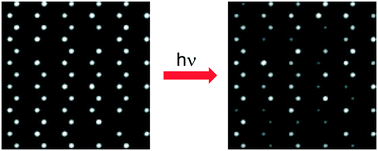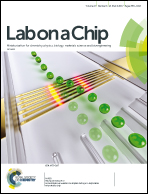Photobleaching kinetics-based bead encoding for multiplexed bioassays†
Abstract
Multiplexing bead-based bioassays requires that each type of microsphere be uniquely encoded to distinguish one type from another. Microspheres are typically encoded using fluorescent dyes with different spectral properties and varying concentrations. However practical limits exist on the number of dyes that can be spectrally resolved or the number of distinguishable intensity levels with each dye. To expand the number of encoding levels, a novel method was developed that incorporates photobleaching kinetics into bead decoding, unlocking additional multiplexing levels unattainable by conventional decoding methods. To demonstrate this technique, beads were encoded with two dyes having overlapping fluorescence excitation and emission wavelengths but different photostabilities. All beads initially exhibited similar fluorescence intensities; however, following appropriate photoexposure, the less photostable dye had reduced emission intensity due to photobleaching. By comparing the original fluorescence emission intensity to that obtained after photobleaching, multiple different populations could be reliably identified. Using only a single excitation/emission band, two different initial intensity levels were optimized to produce six uniquely identifiable bead populations whereas only two could have been achieved with conventional decoding methods. Incorporation of this encoding strategy into bead-based microwell array assays significantly increases the number of encoding levels available for multiplexed assays without increasing the complexity of the imaging instrumentation.



 Please wait while we load your content...
Please wait while we load your content...